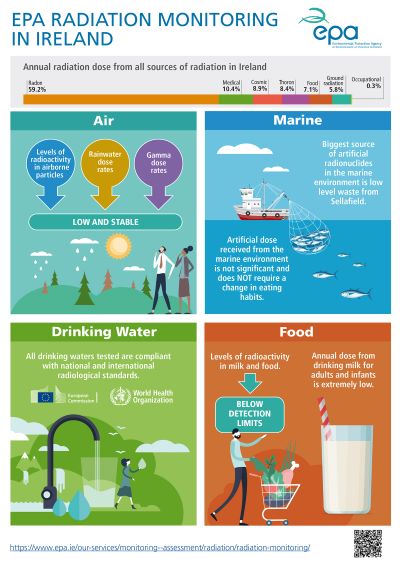Radiation monitoring in Ireland
Radiation monitoring in Europe
The EPA monitors concentrations of radioactivity in the Irish environment to establish baseline levels and assess if there are any trends over time and what this might mean for people in Ireland.
In the EPA marine monitoring programme radioactivity is measured in samples of seawater, seaweed, sediment, fish and shellfish from around the coast of Ireland.
The EPA also has monitoring programmes to measure radioactivity in food and drinking water.
Levels of radiation in the Irish environment from human-made sources are very low and do not pose a risk to human health or the environment.

EPA’s Role in Monitoring Radioactivity in the Irish Environment
Under Irish law, the EPA is responsible for monitoring radioactivity in the Irish environment.
The EPA monitors concentrations of radioactivity in the Irish environment to establish baseline levels and assess if there are any geographical trends or trends over time and what this might mean for people in Ireland. If, in the unlikely event of a nuclear accident abroad causing contamination of the Irish environment, the EPA can evaluate the consequences of increases in radioactivity in food stuffs or the environment.
Monitoring and sampling
Key elements of the EPA radiation monitoring programme are:
- to monitor and assess levels of radiation in the environment.
- to support the Irish food and agriculture industry through assessment of radionuclides in Irish foodstuffs.
- to maintain systems, procedures and expertise to ensure increases in radiation levels resulting from a nuclear emergency or radiological incident in Ireland are detected and assessed rapidly.
- to support evidence-based information and advice on radiation levels in the environment to Government and the public; and
- to comply with statutory and international obligations concerning environmental monitoring and individual and population dose assessment.
The radiation monitoring programme includes 24-hour measurements from the permanent monitoring network and a programme of sampling followed by laboratory testing of radiation in drinking water, food, seawater, seaweed and other environmental samples.
Radiation monitoring in Europe
Similar routine sampling and testing of the environment is carried out in every EU country. The results are compiled and are available to view online in the Radioactivity Environmental Monitoring data base.
In addition, gamma dose rate data from our permanent monitoring network is transferred to a European Commission database. Similar data from all EU countries is collated and can be viewed here.
Article 35 of the Euratom Treaty requires Member States to establish facilities necessary for continuous monitoring of radioactivity levels in the air, water and soil ensuring compliance with the Basic Safety Standards. Further stipulations include... “The Commission having the right of access to facilities; it may verify their operation and efficiency.” In accordance with Article 35, the Commission carries out a programme of Verification visits in Member States. The main purpose of such visits is to provide an independent assessment of the adequacy of monitoring facilities for environmental radioactivity.
A report of the Commission's most recent Verification visit to Ireland can be found on the European Commission website.